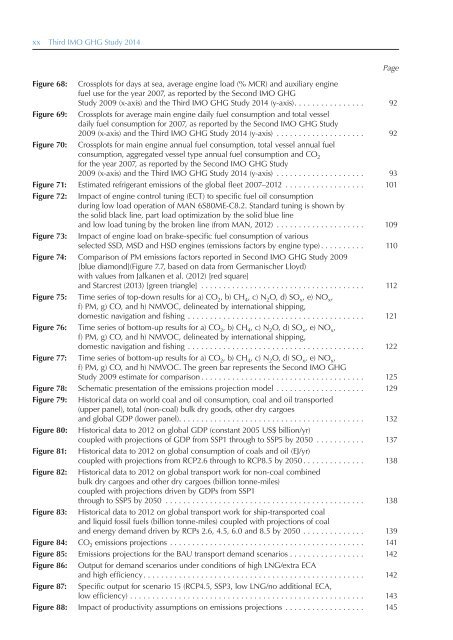MnrAq
MnrAq
MnrAq
You also want an ePaper? Increase the reach of your titles
YUMPU automatically turns print PDFs into web optimized ePapers that Google loves.
xx Third IMO GHG Study 2014<br />
Page<br />
Figure 68: Crossplots for days at sea, average engine load (% MCR) and auxiliary engine<br />
fuel use for the year 2007, as reported by the Second IMO GHG<br />
Study 2009 (x-axis) and the Third IMO GHG Study 2014 (y-axis) ................ 92<br />
Figure 69: Crossplots for average main engine daily fuel consumption and total vessel<br />
daily fuel consumption for 2007, as reported by the Second IMO GHG Study<br />
2009 (x-axis) and the Third IMO GHG Study 2014 (y-axis) .................... 92<br />
Figure 70: Crossplots for main engine annual fuel consumption, total vessel annual fuel<br />
consumption, aggregated vessel type annual fuel consumption and CO 2<br />
for the year 2007, as reported by the Second IMO GHG Study<br />
2009 (x-axis) and the Third IMO GHG Study 2014 (y-axis) .................... 93<br />
Figure 71: Estimated refrigerant emissions of the global fleet 2007–2012 .................. 101<br />
Figure 72: Impact of engine control tuning (ECT) to specific fuel oil consumption<br />
during low load operation of MAN 6S80ME-C8.2. Standard tuning is shown by<br />
the solid black line, part load optimization by the solid blue line<br />
and low load tuning by the broken line (from MAN, 2012) .................... 109<br />
Figure 73: Impact of engine load on brake-specific fuel consumption of various<br />
selected SSD, MSD and HSD engines (emissions factors by engine type) .......... 110<br />
Figure 74: Comparison of PM emissions factors reported in Second IMO GHG Study 2009<br />
[blue diamond](Figure 7.7, based on data from Germanischer Lloyd)<br />
with values from Jalkanen et al. (2012) [red square]<br />
and Starcrest (2013) [green triangle] ..................................... 112<br />
Figure 75: Time series of top-down results for a) CO 2 , b) CH 4 , c) N 2 O, d) SO x , e) NO x ,<br />
f) PM, g) CO, and h) NMVOC, delineated by international shipping,<br />
domestic navigation and fishing ........................................ 121<br />
Figure 76: Time series of bottom-up results for a) CO 2 , b) CH 4 , c) N 2 O, d) SO x , e) NO x ,<br />
f) PM, g) CO, and h) NMVOC, delineated by international shipping,<br />
domestic navigation and fishing ........................................ 122<br />
Figure 77: Time series of bottom-up results for a) CO 2 , b) CH 4 , c) N 2 O, d) SO x , e) NO x ,<br />
f) PM, g) CO, and h) NMVOC. The green bar represents the Second IMO GHG<br />
Study 2009 estimate for comparison ..................................... 125<br />
Figure 78: Schematic presentation of the emissions projection model .................... 129<br />
Figure 79: Historical data on world coal and oil consumption, coal and oil transported<br />
(upper panel), total (non-coal) bulk dry goods, other dry cargoes<br />
and global GDP (lower panel). . . . . . . . . . . . . . . . . . . . . . . . . . . . . . . . . . . . . . . . . . 132<br />
Figure 80: Historical data to 2012 on global GDP (constant 2005 US$ billion/yr)<br />
coupled with projections of GDP from SSP1 through to SSP5 by 2050 ........... 137<br />
Figure 81: Historical data to 2012 on global consumption of coals and oil (EJ/yr)<br />
coupled with projections from RCP2.6 through to RCP8.5 by 2050 .............. 138<br />
Figure 82: Historical data to 2012 on global transport work for non-coal combined<br />
bulk dry cargoes and other dry cargoes (billion tonne-miles)<br />
coupled with projections driven by GDPs from SSP1<br />
through to SSP5 by 2050 ............................................. 138<br />
Figure 83: Historical data to 2012 on global transport work for ship-transported coal<br />
and liquid fossil fuels (billion tonne-miles) coupled with projections of coal<br />
and energy demand driven by RCPs 2.6, 4.5, 6.0 and 8.5 by 2050 .............. 139<br />
Figure 84: CO 2 emissions projections ............................................ 141<br />
Figure 85: Emissions projections for the BAU transport demand scenarios ................. 142<br />
Figure 86: Output for demand scenarios under conditions of high LNG/extra ECA<br />
and high efficiency .................................................. 142<br />
Figure 87: Specific output for scenario 15 (RCP4.5, SSP3, low LNG/no additional ECA,<br />
low efficiency) ..................................................... 143<br />
Figure 88: Impact of productivity assumptions on emissions projections .................. 145


